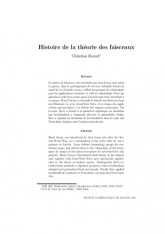
- Consulter un extrait
- Année : 1998
- Tome : 3
- Format : Papier
- Langue de l'ouvrage :
Français - Class. Math. : 01A65, 55-03, 14-03, 35A27
- Pages : 101-119
La notion de faisceau a été introduite par Jean Leray juste après la guerre, dans le prolongement de travaux entrepris durant sa captivité en Autriche. Leray a défini des groupes de cohomologie pour les applications continues, et relié la cohomologie d'une application à celle de sa source grâce à la suite spectrale, introduite à ce propos. Henri Cartan a reformulé la théorie des faisceaux dans son Séminaire et, avec Jean-Pierre Serre, il en donna des applications spectaculaires à la théorie des espaces analytiques. Par la suite, Serre a étendu à la géométrie algébrique ces méthodes que Grothendieck a largement rénovées et généralisées. Enfin, Sato a exploité les méthodes de Grothendieck dans le cadre des $\mathcal D$-modules, fondant ainsi l'analyse microlocale.

